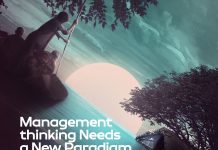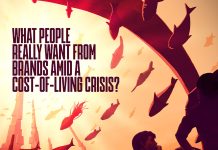I never planned to be an adman, but once I stepped into this fascinating world especially into the strategic planning function, I started to love it with each passing day.
Having spent two lazy months after moving back to Pakistan, I decided to pen down a few things I learnt about planning over the years, and share my experiences with the marketing fraternity here at home.
“While working on a project, I would often write the brand’s marketing objectives on a piece of paper and keep them at a stare’s distance, so that I will not get diverted from them.”
Begin With the End in Mind
I am sure most of you are familiar with the ‘7 Habits of Highly Effective People’, written by Stephen Covey and extensively talked about in corporate cultures all over the world. I just love the narrated habit # 2; ‘Begin with the End in Mind’, as it perfectly conforms to what my job is, day in and day out.
While working on any project, the first question I would usually ask is, “What are we trying to achieve?”, and this is where it becomes of paramount importance to exactly know the client’s/brand’s business-marketing-campaign objectives and the KPI’s the communication is to be measured against. I would quite often write those objectives on a piece of paper and keep them at a stare’s distance, not to get diverted from them. Being connected and aligned with these objectives when recommending solution(s) helps in attaining focus as well as identify and explore relevant ideas.
The Brief has yet to get Comprehensive
As an adman once famously said, “If you don’t have an ad, you don’t have a brief”. That is, if I can’t produce an idea from my own brief, I should not expect the creative team to come up with one. As a planner, I am accountable for being ‘useful’ to the creative team and other disciplines to act like a springboard, giving practical and valuable suggestions. For instance, it is not enough for me to tell any of the teams to go from Lahore to Islamabad for a meeting, rather I also have to support them by instilling a direction about the most efficient ways of reaching Islamabad, and how to prepare for an effective meeting.
I have learnt that the brief needs to be treated as one of the most important documents in our lives. This has resulted in and continues to result in effective communication ideas, gives the satisfaction of achieving the client’s business-marketing objectives and finally, gives us a reason to be proud of ourselves.
Before writing any major creative communications brief, I ask myself these questions; “Why is this brief here?”, “What are the key objectives that the brand intends to achieve?”, “How best can the brand achieve these objectives?”, and above all, “How can the brand make a positive difference in people’s lives?”
One of my former bosses (who taught me, what I know today!) used to say, “Stay away from jargon and keep it simple. The words that you use should be able to support your creative team in generating ideas.”
Another important thing that I learnt over the years: There is a reason the document is called a “brief”. One doesn’t need to write a whole article or a multiple pager, rather it is our job to keep it succinct, focused and inspiring; so that it can act as fuel for generating ideas.
The Briefing: A Chance to Bring Words Alive
I have learnt that more important than the brief is the “creative briefing” session and it is never to be ignored. This is the time when you bring your brief to life and give it a kick; to tell the story you want, capture imagination and inspire the creative team, provoke questions, and generate ideas. To ensure a successful briefing session use pictures, videos, everyday life situations, metaphors; anything to get your creative team’s brains running. Take care not to bore them.
During such a session, use your brief as a “discussion document”. It should be something that sparks conversations, which can further lead to effective ideas. Try not to complicate things, simplicity always wins over complexity.
Listen and Collaborate to Win
Our perceptions are a reality for most of us, but it is important that not to get caught in a one dimensional and rigid thinking process that proves us to be “always right”.
I may think of myself as Superman; however I have to realize that my Creative Director can be Batman, Account Director may be Iron Man, the digital resource a Spiderman and above all, the client a Hulk. In short, it is critical to see the world from others’ perspective, NOT ACT AS TERRITORIAL GENERALS, and imagine and collaborate together. Imperative to keep in mind: Everyone in a team is working to achieve the same objective.
“If you can’t produce an idea from your own brief, you should not expect your creative team to come up with one.”
Insight, Opportunity and Ideas
I believe ‘insight’ is the most overused and abused word in our business. Ad-men (and women) quite often talk about ‘Consumer Insight’, and how it should lead to the creative idea. Yet, here I am, a person who will never ignore the brand, the product and the environment it operates in.
Although the consumer part is highly important and can’t be neglected, I strongly believe that insightful ideas MUST not be limited to consumer insights only and can come from anywhere within the brand, product, or cultural framework. The key is to unearth the most relevant consumer demand and marry it with the brand or product promise and the cultural truth in the shape of a consumer advantage and value addition. Look deep into the brand, its philosophy, its promise and even the way it is produced; the insight may be hidden underneath these unexplored layers.
Where do you think, “Audi – Vorsprung Durch Technik”, came from? It is inspired from the brand belief and brand philosophy. By the way, it is translated as, “Advancement Through Technology”. Look at the cultural and societal truths and you will find clues everywhere around you. “Malaysia, Truly Asia”, is a seamless cultural insight and an undeniable fabric of the country.
Remember the breakthroughs that Samsung (Samsung DIGITall. Everyone’s invited.) and LG (Digitally yours) made in our lives during the 90’s by introducing digital technology in often boring home appliances, and made us seek them out to make our lives easier? Both these brands exploited the core product strengths as insights, which led to the consumer demand for convenience.
Whenever I work on a brand or a project, I try and make sure to keep my perspective open. This not only gives me a broader prospect of the situation, but also helps in identifying the most effective opportunity for the brand.
“Our perceptions are a reality for most of us, but it is important not to get caught in a one dimensional and rigid thinking process that proves us to be “always right”.”
Integration is Effective
Remember the old story of a farmer whose sons used to fight each other and close to his death he teaches them a lesson about how powerful unity is?
Similarly, in business collaborations, integration and making various disciplines come together behind an idea is the key to winning campaigns and driving results. Here, ideas are more significant than channels; such ideas that are powerful and flexible enough to be effectively integrated across disciplines and across channels.
A few ideas like, “Just Do It” by Nike, “Keep Discovering” by Emirates, “Real Beauty” by Dove and “Open Happiness” by Coca-Cola are clear examples and vivid proofs of the power of a good idea, and you can see how these ideas have been exploited and integrated across different channels of communication over the years, without alienating the core of the brand.
Who Should You Be in the Entire Process?
The Honda Cog ad wonderfully resonates with my job and I simply love it. Consider yourself that Cog which sparks a chain reaction and gets things rolling. Basically, that cog which acts as a catalyst for the entire process to work and accomplish things. For those of you, who haven’t seen this ad, search for the ‘Honda Cog ad’ on YouTube and watch the first result on the list.
Besides this, I really love one of Jon Steel’s 13 minutes videos, which I recommend those reading this search on Google and listen to, “WPP’s Planning Guru Jon Steel on What He Values Most in a Planner!”. Amongst others, one of the most inspiring arguments in the video is about being ‘useful’ and the ability to ‘bring out the best in other people’. This is where I have felt one can really make a difference; by being a part of the solution and an effective member of the team.
About the Author
Omer is former Strategy Director at FP7, TBWA\ and Ogilvy & Mather in the GCC region. He recently joined BBDO Pakistan as Business Director after moving back to Pakistan, and can be reached at omerazeem@gmail.com.














